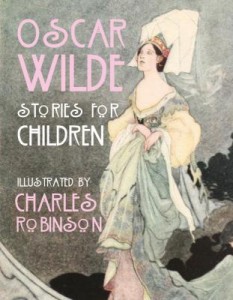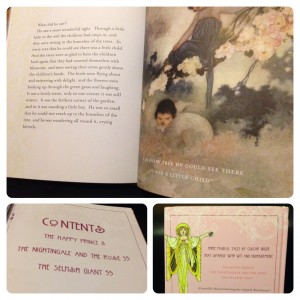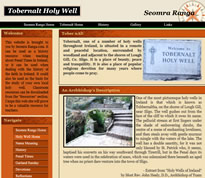 When Damien asked me to review “Oscar Wilde Stories for Children” I was thrilled. I’ve always loved Oscar Wilde, his stories are full of beautiful images and morals, something I love in all that I read. This book is especially beautiful as the illustrator’s talent shines through and really brings the stories to life. The book has three well known stories included: “The Happy Prince”, “The Nightingale and the Rose”, and “The Selfish Giant”. All have morals built in, perfect for a classroom lesson!
When Damien asked me to review “Oscar Wilde Stories for Children” I was thrilled. I’ve always loved Oscar Wilde, his stories are full of beautiful images and morals, something I love in all that I read. This book is especially beautiful as the illustrator’s talent shines through and really brings the stories to life. The book has three well known stories included: “The Happy Prince”, “The Nightingale and the Rose”, and “The Selfish Giant”. All have morals built in, perfect for a classroom lesson!
“The Selfish Giant” is all about being kind, sharing and loving others. “The Happy Prince” is again about being kind and sharing, in particular giving to the poor and less fortunate. Finally “The Nightingale and The Rose” is all about love and sacrifice – the nightingale sacrifices everything for love, the young student and girl in the story know nothing of love.
All of the stories have clear religious elements, where Wilde’s religion and beliefs are portrayed throughout the three stories. Wilde’s religion was clearly important to him and we can see that in each of these stories. “The Happy Prince” finishes with God requesting the most valuable things in town which are the Happy Prince statue and the little bird. They’re both rewarded for their efforts in helping the poor and offering up their own lives to do God’s work. “The Selfish Giant” meets Jesus at the end of the story when the first child he ever helped and loved returned to him with marks on his hands, implying that he is Jesus and is bringing the Giant to Heaven.
 “The Nightingale and The Rose” is slightly different when compared to the other two. The Nightingale sacrifices everything for love, much like Jesus did, but the Nightingale’s sacrifice went unnoticed and on some level Oscar Wilde is drawing comparisons between Nightingale’s ignored sacrifice and lowered interest in religion in society, something we’re still experiencing many years after Wilde’s observations.
“The Nightingale and The Rose” is slightly different when compared to the other two. The Nightingale sacrifices everything for love, much like Jesus did, but the Nightingale’s sacrifice went unnoticed and on some level Oscar Wilde is drawing comparisons between Nightingale’s ignored sacrifice and lowered interest in religion in society, something we’re still experiencing many years after Wilde’s observations.
The illustrator, Charles Robinson, brings the stories to life with carefully drawn images, some of which are striking and draw the eye straight over. Others aren’t as bright and striking but convey elements of the story as vital as Wilde’s words themselves. I love the detail within the drawings – Robinson uses bright colours in all the right places, drawing our attention to images at the side of the page often. He also uses darker colours to convey the sadder images within the story such as the beggars or the young writer in “The Happy Prince”. The images and illustrations are a key part to this book and will captivate any reader.
Would I bring this into my classroom? Yes I would, but carefully. I’ve always loved Oscar Wilde, however I know some parents wouldn’t be too enthusiastic about all the religious connotations in the book and the constant reference to God and Jesus. That said, in my opinion, the morals in each story far outweigh the religious aspects for me.
This book is published by O’Brien Press and is available to purchase HERE
Helen Bullock is a primary substitute teacher based in the south west. Before becoming a primary teacher she studied English Literature and Irish in University College Cork. Helen has always been interested in literature and literacy and tries to bring that into every class she teaches. Helen runs the website www.anseo-a-mhuinteoir.com and recently published her first book “How I Learn” which can be found on Amazon and iBooks





